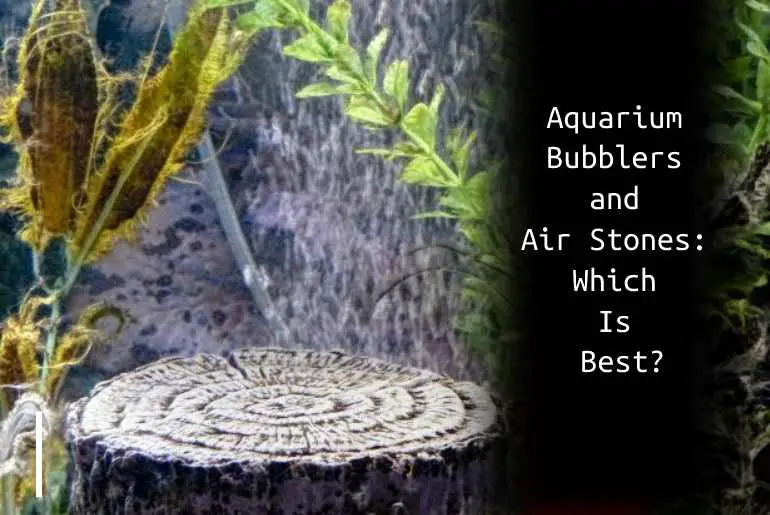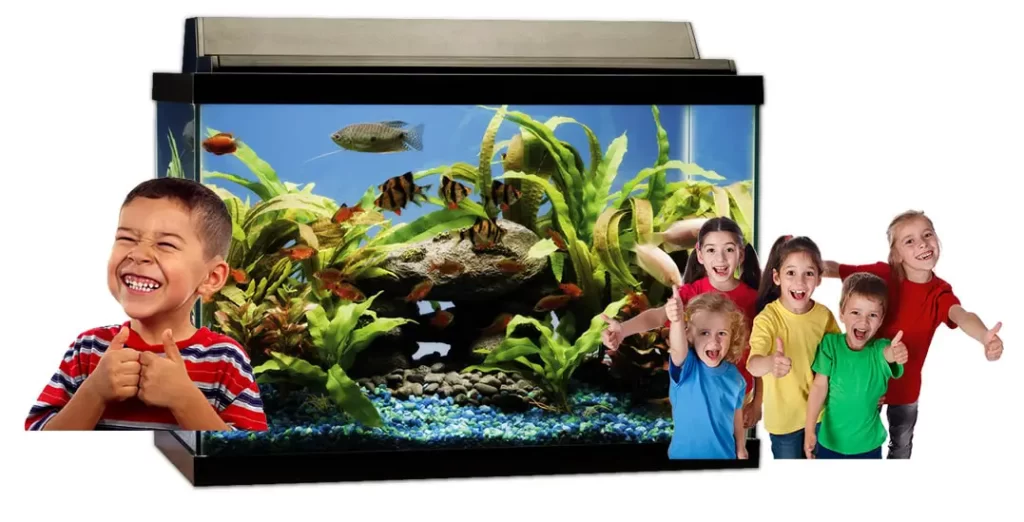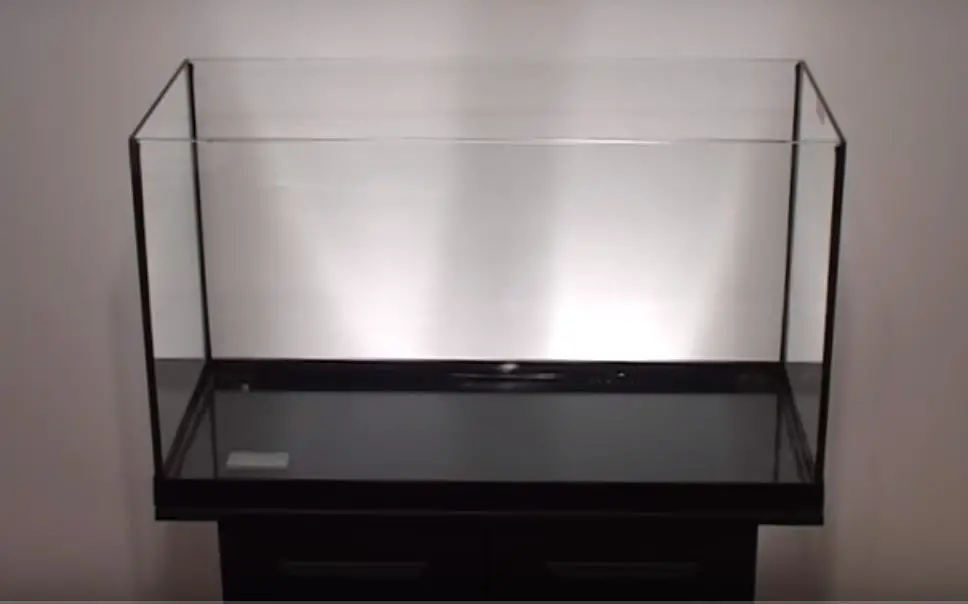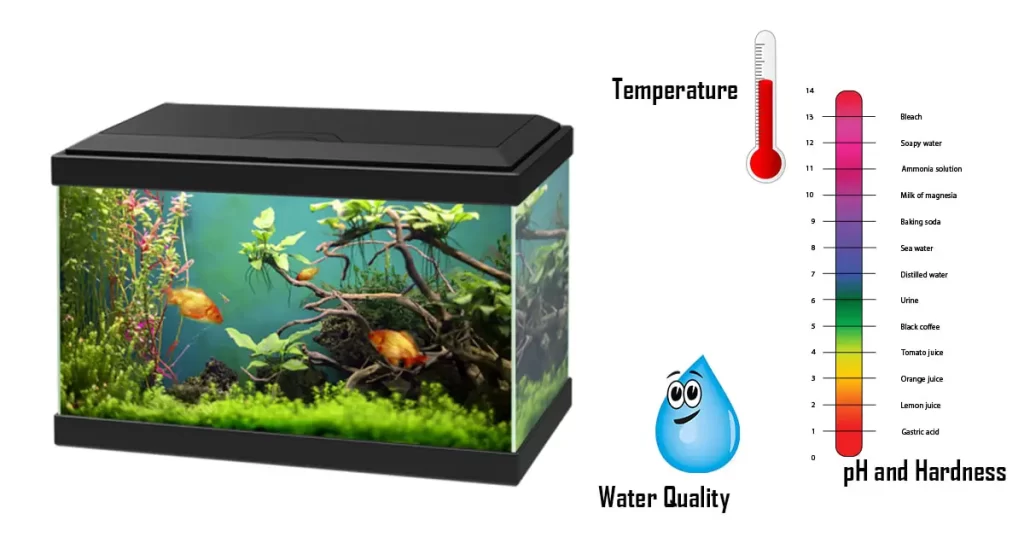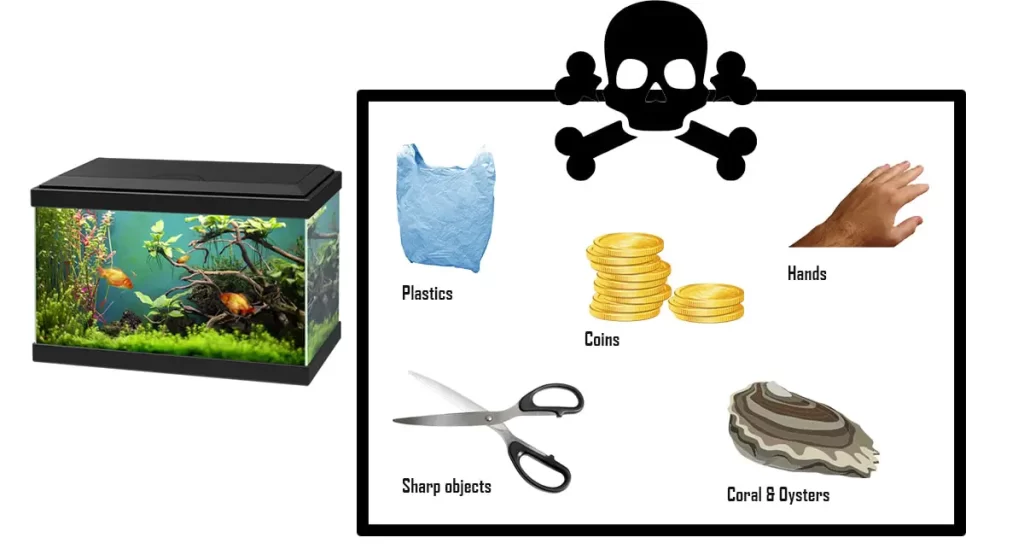If you enjoy aquariums and have a lovely fish tank in your home, it is likely that you wish to decorate it with attractive fish and floating plants.
But did you know that air stones and bubblers can be a crucial component of your aquarium by giving it enough oxygen and enhancing the environment with gorgeous bubbles? In a word, yes!
In order to familiarize you with the top air stones on the market, this guide was created.
We use tank filters to remove waste and dangerous items from our fish tank. However, many of us are unaware that air stones are also beneficial because they speed up the circulation system in our aquarium by giving the fish ample oxygen.
This article includes reviews of the top 8 aquarium air stones as well as advice on how to install and maintain them.
What Is An Air Stone For Aquariums?
Aquarium air stones and aquarium bubblers are items that float in your fish aquarium and spread air. A cluster of small bubbles inside the water indicates the release of air. These goods are utilized to add more oxygen to the water while somehow giving your fish something to do.
How Do They Function?
The typical steps for using these goods are listed below:
- An electromechanical air pump must be connected to air stones for them to work.
- The tank will then begin to bubble as they begin to release air.
- When the bubbles reach the water’s surface, oxygen diffuses into the liquid.
- To make sure that air reaches every part of the tank, they generate a tiny current while doing this.
The air stone could operate a very little bit differently depending on the brand. You can refer to the product’s instructions if you are unsure about how to set up and operate an air stone.
What Purpose Does An Aquarium Bubbler Serve?
By stirring up the water’s surface and allowing oxygen to diffuse into the water column, aquarium bubblers are employed to give more oxygen to your tank.
Many enthusiasts utilize an aquarium bubbler to add a shimmering bubble curtain to their tank’s rear wall, which improves the tank’s aesthetic appeal.
A bubbler is not necessary to oxygenate your water tank. Many HOB filters and canister filters have outflow components, including trays and spraying rods, that agitate the water’s surface enough to oxygenate the water. An air bubbler is necessary if you intend to maintain frogs, crabs, shrimp, or newts, which require extremely well-oxygenated water.
The Advantages Of Air Stones In Your Aquatic Tank
If the water in an aquarium does not move around much, one of the major reasons to add an air stone is that. It is possible that its water is not being circulated enough if you glance at the water’s surface, and it is largely undisturbed.
The oxygen is added to the water indirectly by air stones. They do this by expanding the surface area to ensure that more water interacts with the oxygen at the tank’s top. This enables more water to absorb oxygen and release carbon dioxide.
An air stone’s greatest advantage is how significantly it boosts an aquarium’s circulation. The water nearer the substrate can be lifted to the tank’s top by the bubbles exceptionally effectively. This is significant since the water is frequently not circulated as frequently as it should be.
An air stone can assist in the circulation of the water more effectively, even if you have an excellent filter, to ensure that as much of it as possible reaches the filter.
Added Oxygen’s Advantages
The aquarium air stone helps prevent the water from being stagnant or even harmful by releasing bubbles into the water. In some circumstances, such as when maintaining too many fish in a tiny aquarium or overfeeding the fish, waste matter in a fish aquarium is quickly out of control. The number of bacteria that consumes the waste material increases as it accumulates. Despite the fact that these bacteria are effectively filtering or cleaning up the “junk” in the tank, they deplete some of the water’s oxygen, which makes it more difficult for fish as well as other aquarium life to thrive.
More Aesthetic And Sound
In the fish tank, the bubbles produced by an air stone may also be used as decorations. Bubble walls and curtains that are placed close to the back of the aquarium add flowing bubble “stripes” behind the fish.
You can also put additional air stones close to ornamental aquarium lost treasures or clam shells that open when bubbles appear. Similar to how some people appreciate the sounds of fountains or flowing streams of water, the persistent bubbling may also be calming.
Supplies For Fish Tank Air Pumps
Whatever the design of the air stone or bubbler, the fish tank’s air pump supplies the air that creates the bubbles. If your aquarium does not already have one, choose an air pump that is appropriate for the capacity of your aquarium.
To choose a pump that is appropriate for the volume of water in the tank, read the pump’s packing. You may control the bubbling’s speed with models that are adjustable.
You will also need to choose the tubing and bubbler, as many machines do not come with these. Purchase the appropriate length of airline tubing to connect your aquarium bubbler to the pump, leaving sufficient tubing to curve over the top of your tank and all the way bottom of the connector.
Suppose you buy the materials from a fish-tank supply store. In that case, you will not often have to worry about choosing the wrong tubing because most airline tubing is offered with a standardized inner diameter of 3/16 inches.
Putting The Aquarium Bubbler In Place
Place the bubbler in the tank’s chosen location after attaching the tubing to the bubbler at one end. Run the tubing down the tank’s bottom and the back corner nearest to the pump, which should be placed close to the aquarium.
That tubing may be kept in place with suction cups made for aquarium use. Connect the pump to the tube’s other end. Use a craft knife to cut off any extra tubing if necessary. Please turn on the pump by plugging it in. The air stone will emit bubbles if everything is connected properly. Restore the tubing at both ends if necessary.
Cleaning A Bubbler In A Fish Tank
A bubbler’s air apertures may eventually get blocked as a result of mineral deposition and debris accumulation. Turn off the pump, take the bubbler from the hose, and rinse it in tap water while cleaning it with a nylon brush if your bubbler is not bubbling as it once did.
The bubbler should be immersed in peroxide for the whole night before being rinsed, scrubbed, dried, and put back in the tank. If the buildup resembles mineral deposits on a spray nozzle and is white and chalky, immerse the bubbler in white vinegar over several hours, then thoroughly clean it before putting it back in the tank.
Bubblers For Aquariums Drawbacks
The use of aquarium bubblers has a few drawbacks:
Additional Expenses And Upkeep
While it is obvious that using an aquarium bubbler adds to your expenses, you do not have to leave the appliance on all the time.
A fish tank requires a significant lot of upkeep, and if you choose to install a tank bubbler, you should be aware that you will need to clean it sometimes to keep the air holes clear of algae and other debris.
Visible Bubbles
Although using air bubbles to make a veil or other patterns in your tank can look nice, not everyone finds the aesthetic appealing. The bubbles may be considered a distraction by some hobbyists who like their fish to be the center of attention.
Therefore, an aquarium bubbler might not be for you if you would rather appreciate the grace and calm of your fish swimming quietly around a magnificently aquascaped tank.
Creeping Salt
Salt creep is something you will be acquainted with if you have a tropical or reef tank. Air pumps and aquarium bubblers can make salt creep worse.
The bubbler stirs the water and promotes flow and movement as it produces bubbles. Additionally, air pumps create bubbles that rupture, sprinkling water everywhere.
Sadly, all that movement increases the likelihood that areas within the tank that normally would not be impacted by the water may come into touch with it. An unsightly coating of salt crystals is left behind after the water dries, adding unneeded extra maintenance labor for the hobbyist.
Bubblers May Be Rather Loud
Many people find aquarium bubblers to be rather noisy, especially if the aquarium is located in an office, school, room, or sitting room, including a television.
The tranquil, stress-relieving atmosphere that the tank is intended to generate can be destroyed by the bubbles, despite the fact that air pumps themself may just make a quiet hum.
Could Cause Stress To Fish
Some fish species, like bettas, are native to regions with calm or even stagnant water. If kept in a tank with a lot of activity, certain species are quickly stressed. Stress can weaken a fish’s immune system, leaving it vulnerable to a parasite or bacterial infections.
In order to avoid introducing fish or invertebrate species which are native to calm waters to an aquarium bubbler, don’t.
The Top 7 Air Stones for Aquarium Oxygenation
Following are our recommendations for aquarium bubblers regarding the most you can get for a decent price, along with other special features:
PENN PLAX Aerator
The PENN PLAX air stones are available if you want to add some consistent bubbles to your aquarium to make it more attractive. Additionally, this tank airstone will fill your aquarium with enough oxygen, which is crucial for your fish and other aquatic life in your aquarium.
Size
Each air stone is approximately 10/2 inches long, making it the ideal size for all small and medium-sized aquariums.
Performance
The air stone is effective in supplying your aquarium with the necessary oxygen. As a result, it aids in your fish and other aquatic plants receiving an adequate supply of oxygen. The stone can be positioned wherever you choose inside the aquarium.
Flexibility
The air stone is easily connected to several other stones at once. This enables you to resize the area to your preferences. Additionally, you can utilize this airstone across both freshwater and saltwater environments.
Unique Qualities
The long-lasting plastic that powers this aquarium airstone guarantees its lifetime. Additionally, it remains on the bottom of your fish tank and does not float away.
Pros
- highly adaptable
- The water is oxygenated.
- Make consistent bubbles
- resilient plastic body
- It can be used in both freshwater and saltwater
Cons
- does not include an air pump.
Flex LED aquarium bubble wand from Aqueon
The Aqueon Flex seems to be a fantastic bubble wand that enhances the oxygenation of your aquarium and adds lovely LED lighting. Aqueon Flex can be a great alternative for you if you wish to create your aquarium look beautiful and enticing.
Size
The Aqueon Flex is available in three sizes: 7 inches, 14 inches, and 20 inches.
Performance
This bubble wand can spread stunning bubbles throughout your fish tank. Additionally, the LED lights embedded in the stone produce a stunning bluish effect throughout your aquarium.
Accessories
An air pump is included with the wand to facilitate the whole tubing operation. Additionally, you will receive suction cups that will firmly secure the wand to the substrate of your aquarium.
Unique Qualities
The bubble wand also has a multi-color feature that, after a certain amount of time, changes its color and gives your aquarium a striking LED effect.
Pros
- There are three sizes available.
- LED lighting outcomes
- The water is oxygenated.
- Make consistent bubbles
- vacuum cups
Cons
- After a few months, the LED life may be over.
2-Inch Wooden Air Diffuser from Lee
This lovely air diffuser has the capacity to spread pretty bubbles across your aquarium. Pure Limewood was used in its construction, which contributed to the creation of lovely bubbles. The diffuser is totally adaptable to all types of water because of this crucial component. Let us learn more about the features this specific product has to offer now:
Dimensions
The air diffuser comes in two sizes, 2 inches and 3 inches. All sizes of aquariums can use them perfectly.
Performance
The limewood in this air diffuser produces natural micropores that produce those eye-catching bubbles and raise the protein skimmers’ efficiency.
Flexibility
This air diffuser can be used in both saltwater and freshwater environments because it is built entirely of lime wood.
Pros
- two sizes available
- composed of lime wood
- Make gorgeous bubbles
- Suitable for both freshwater and saltwater use
Cons
- no small bubbles
Aqueon Flexible LED Bubble Wand in Multiple Colors
Aqueon Multi-Color is your best option if you want to embellish your aquariums with a lovely bubble brush that can periodically produce multiple LED effects that change color.
Size
There are two different sizes available for the bubble wand. They come in two sizes: 14 inches and 21 inches.
Performance
A color-changing feature on the bubble wand allows a choice of three different hues. The multicolor feature sometimes transforms the light into a varied variety of hues in addition to white and blue.
Flexibility
The bubble wand’s incredible flexibility makes it possible to bend the rod into whatever form you like.
Additions
The bubble wand comes with suction cups that will firmly secure the rod to the substrate of your aquarium.
Pros
- available in two sizes
- hue-shifting effects
- oxygenates the water and produces consistent bubbles
- supplies suction cups
Cons
- After a few months, the LED life may be over.
1.6″ Air Stone Bubble by Pawfly
This air stone from Pawfly may quickly transform your aquarium into an artistic beauty by exploding with small and huge bubbles covering the entire stone area.
Size
There are four air stone discs in the bundle, each measuring around 1.6 inches.
Performance
The air stone is intended to oxygenate the entire aquarium, which will be quite beneficial for living fishes and other water plants. It also creates lovely bubbles. Additionally, people make air stones from premium mineral material, which offers high-performance bubble formation in your aquarium.
Pump
A pump is necessary for the air stone’s operation. You can purchase a 2.5w to 5w pump to run this stone effectively.
Unique Qualities
This aquarium airstone produces bubbles that range in size from little to enormous. Lowering the carbon dioxide levels inside your fish tank establishes a strong circulation mechanism.
Pros
- Four air stone fragments
- The water is oxygenated.
- Make consistent bubbles
- made with premium minerals
- lowers CO2 levels
Cons
- does not include an air pump.
1-inch Aircore Sand AirStone from JW Pet Company
A little 1-inch aquarium air stone called the JW pet can be placed in any little tank. It is capable of spreading a large number of bubbles throughout your fish tank. The air stone has a distinctive shape and can be powered by the majority of air pumps in use today.
Size
The air stone can be positioned in awkward or unnoticeable regions of your aquarium. It is one inch in size.
Performance
The airstone can produce both many little and huge bubbles since its surface is entirely porous. Additionally, it significantly aids the stone in improving the circulation system and distributing enough air throughout your aquarium.
Flexibility
The main distinction is determined by the air stone’s size. You can put it inside a small aquarium of any size or in a hidden corner of your holding tank.
Unique Qualities
This air stone for aquariums has a distinctive form and provides a porous surface.
Pros
- Only one inch in diameter
- The water oxygenates
- Make both little and big bubbles.
- Specifically Shaped Super Porous Surface
Drawbacks
- Does not include an air pump.
4-Inch Air Stone Disc Bubble Diffuser by Pawfly
If you have an indoor aquarium that is between medium and big size, the said Pawfly 4-inch air stone is the ideal option. This potent stone may significantly enhance the overall flow system within your aquarium and comes with a one-month refund guarantee.
Size
The air stone disc is four inches in size and fits into most fish tanks with ease.
Performance
To keep your fish healthy, this potent air stone can quickly produce a large number of bubbles inside your aquarium and oxygenate the entire tank.
Unique Qualities
For consistent function, you can wash this aquarium air stone occasionally thanks to its washable feature. Additionally, it has suction cups that will keep the stone firmly attached to the aquarium’s bottom.
Pros
- Favorable for large aquariums
- The water is oxygenated.
- Massively produce bubbles
- 30-day money-back guarantee
- tenacious suction cups
Cons
- a little big for little tanks
Air Stones Vs Air Diffusers
In domestic and hydroponic horticulture, diffusing oxygen is utilized for a variety of activities, including as dechlorinating water and supplying enough oxygen in aquaponics systems.
Pumping air from the room through a distributing pump, stone, or pump produces tiny bubbles that add extra oxygen to the water. This process is known as diffusing oxygen.
This procedure is crucial in a deep water culture system because it enables the roots to remain completely buried in the nutrient solution while still having access to the oxygen often present in well-aerated soil for planted tanks. It also helps in maintaining the CO2 and oxygen levels in the tank.
What Distinguishes Air Diffusers From Air Stones?
All aquarium ecosystems require the usage of air pumps as well as air stones and diffusers.
Roots in processes, including DWC, and ebb and flow, may suffocate in the absence of more oxygen.
The design and aesthetics of air stones and diffusers are the only substantial differences between them. In essence, they carry out the same action.
As its name suggests, you can see air stones in shapes like a stone or cylinders. On the other hand, you can use air diffusers in shape to work more effectively and cover a larger surface area.
Air Pump
You will require an air pump for your diffuser for it to function. The air your stone or diffuser delivers in the aquarium is actually produced by them. The good news is that these just require a small additional investment and cost as little as $15!
Remaining with the same brand is smart, but make sure the air pump you buy matches the stone or diffuser you buy.
If you are unfamiliar with hydroponics, we advise you to read our Hydroponics 101 tutorial to understand this method of growing better and decide if it is appropriate for you.
How To Clean Air Stone In An Aquarium?
After a set amount of time, you must clean your Air stones since they gradually become clogged with dirt and debris. As a result, it hinders their performance, which you must fix by promptly cleaning them. Let us discover several actions:
- Aquarium air stone cleaning Simply uses fresh water to wash all the dirt and debris away. Enable these air stones to dry thoroughly after that.
- Simmer your air stones for about ten minutes in some fresh water. Then, let the air stones dry completely before using them.
- Spend the whole day soaking your air stones in a 1:3 mix of freshwater and bleach. If it has been seriously backed up, you can extend the time. The air stones should now be taken out of the solution and placed in a bucket of fresh water. All conceivable junk that might come in the path of the air stones will be removed throughout this procedure.
- A 12-hour bath in hydrogen peroxide is another option. You should pump the aquarium airstone with air until it is fully dry.
Why Isn’t The Bubbler In Your Aquarium Functioning Properly?
The intensity of the air pump determines how well a bubbler works. A weak one will not be able to exert the pressure required to force air through and form bubbles.
This issue most frequently occurs with bigger aquarium bubblers when the air pump is not strong enough to force air across the bubbler’s full surface. You may readily purchase a powerful air pump to solve the issue.
Your bubbler may have a leak if you observe that bubbles only come out of the base. This is especially typical with less expensive air stones when the foundation is not firmly cemented on.
You may usually use epoxy resin to plug the leak, which will allow you to solve this issue.
Where Should I Put The Aquarium’s Air Stone?
Although you must position air stones at the tank’s bottom, you must consider several additional factors. Initially, be sure to position it away from the filter. The air stone’s bubbles will not have as much of an impact on the water if they enter the filter first. Even worse, they might damage your filter.
In order to prevent the bubbles from obstructing any open spaces where your fish swim, it is a good idea to arrange the air stone in your tank amongst plants and other decorations. Try moving your airstone to a more private section of the aquarium if you place it there, and fish avoid it or hide there. One option to attempt to keep the bubbles away from the area where your fish prefer to swim is to place them behind plants.
Under the gravel substrate, you can also install air stones. If your fish seem bothered by the bubble flow above the gravel, this is a terrific technique to get them out of the way and gain a bit more control.
FAQ
Is A Fish Tank Air Bubbler Beneficial?
Although you rarely require air pumps, there are only a few situations in which a tank would not benefit from them. The existence of an air pump might agitate some fish species, including bettas, who prefer motionless water. But most of the time, air pumps help fish because they give them extra oxygen to breathe.
Should You Always Use Airstone?
It is best to leave it on constantly. Algae will ultimately accumulate and block the airstone’s holes, forcing your pump to work harder and finally wearing it out. Regardless of whether it is on all the time, this will still occur, but the lead-up will take longer.
Do Bubbles In Water Oxygenate It?
Your fish tank gets oxygen from the bubbler. The bubbles appear to release oxygen into the water. However, this only affects a very small portion. The procedure of gas exchange causes the majority of the oxygen inside the fish aquarium to enter from the surface and dissolve into the water.
Can An Aquarium Contain Too Many Air Stones?
Depending upon which fish and the issue that concerns you. It is impossible to accumulate too much-dissolved oxygen because its maximum concentration is 12 ppm. If you are concerned about turbulence, it varies on your fish, but most can handle the slight turbulence brought on by airstones just perfectly.
Conclusion
Aquariums can benefit greatly from air stones. A continual stream of bubbles gives any aquarium an intriguing appearance, but they also serve many other purposes. In addition to being visually appealing, the bubbles perform an essential task by assisting in the circulation of water from the tank’s bottom that might not otherwise reach the filter.
Keep in mind that an air stone will need some maintenance and cost you a little extra fuel to run. Additionally, a tank holding delicate fish species that live in still water in their native habitats should not be filled with an aquarium bubbler.

